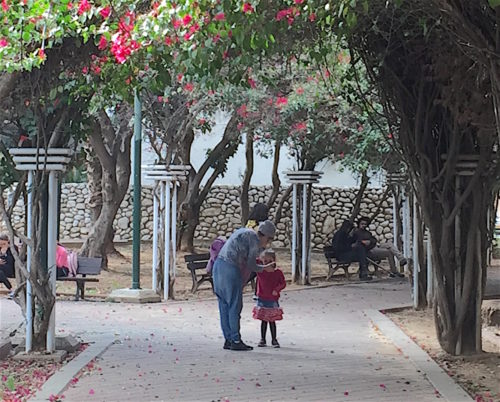
Oy! I can’t fall asleep on airplanes, so I’ve spent most of my first week in the Tel Aviv area jet-lagged and miserable. The symptoms are flu-like: Headache, muscle ache, cough, dehydration and narcolepsy. My Israeli cousin’s two-bedroom apartment, loaned to me for a few weeks, is sufficient except in one way. When I flipped the red wall switch to turn the flash heater on, the circuit breaker blew.
Goodbye hot shower. Goodbye broadband. Fortunately, with the help of a neighbor, I found the electrical panel on the terrazzo landing, restoring precious WIFI. I haven’t retried the hot water switch yet.
I confess to having become a fair weather journalist. If it’s winter in east-central Pennsylvania, then you can bet that RIJ’s virtual offices will be far from there, someplace where the weather is mild and the local retirement financing system promises an interesting case study. Two years ago we relocated to Costa Rica for a month. Last year the destination was Seville, Spain. This year, it’s Israel.
To get sorted quickly in another country, I’ve developed a drill. It begins with a stroll around my new neighborhood. My experience with middle-class neighborhoods in Europe and Asia is that you can readily find small shops or stalls that sell the essentials: Bread, eggs, bottled water, wine, fresh vegetables, laundry and barbering services, and so forth. This busy understory of informal commerce (thriving below the skyline of banks, office buildings and apartments) usually includes small clubs and restaurants as well.
That’s been true of Yehud, the suburb east of Tel Aviv where I’m staying. But the mom-and-pop economy here looks endangered. Yehud is growing fast, with new luxury apartment towers rising amid grimy, laundry-hung apartment blocks from the 1970s and old, terra cotta-roofed stucco cottages from the preceding agricultural period. Underdevelopment is yielding to overdevelopment (i.e., gentrification) in real time. And the population seems relatively young. Children—in daycare centers, in strollers, in pairs walking home from school—are commonly seen and heard.

It’s a mother and child reunion, in Yehud.
But let’s stay on task. Retirement experts who know Israel, including Zvi Bodie, Moshe Milevsky and Meir Statman, have graciously furnished me with the names and email addresses of some of their contacts in academia, government and business here. I was able to find a few more on my own, including Shlomo Benartzi, the UCLA behavioral economist, author and consultant who divides his time between Israel and the US.
Wednesday morning, I reached the first of my contacts. Over Skype (I don’t have local cell service yet) I interviewed Jack Habib, recently retired as the director of research at the National Insurance Institute. Next week, I’ll meet over coffee with Orly Sade, a professor at Hebrew University, who recently wrote about the consequences of mandatory partial annuity purchases at retirement. On Sunday morning, I’ll have breakfast at Café Hillel in Jerusalem with Gil Weinreich, the former Research magazine editor who lives here now and works for seekingalpha.com.
Israel’s retirement policy pivoted in 2008. Workplace defined contribution (DC) plans became mandatory (though compliance is said to be incomplete among small firms). Workers contribute to pre-tax pension funds (which also provide disability and unemployment benefits), or to after-tax “provident funds,” or to a third option, called manager’s insurance (for high earners). Those who save in pension funds must use enough of their savings (since 2008) to buy an annuity paying about $1,200 a month; they can take the balance as a lump sum. That program is only 10 years old, so few people have reached the annuitization stage. I could be wrong on a few of these details–it’s confusing.
In addition to these “occupational schemes,” there’s a basic old age pension, akin to our Social Security. It provides 1,554 shekels ($423) per month for individuals and 2,335 shekels ($635) per month for couples. There are also supplements and adjustments for various situations. As in the US, many retirees, including former government workers and career military personnel, still receive defined benefit pensions from closed or ongoing plans. And there’s personal savings and investment, of course.
Between interviews and deadlines, I hope to visit some of the sites that so many have fought over for so long: Jerusalem, the Dead Sea, Masada, Beer Sheba and the Negev desert in the south, and Haifa, Acre, and the Sea of Galilee in the north. I arrived knowing little more about contemporary Israel than what I’ve seen in the American news media; only gruesome events in the Middle East tend to get coverage. So far, the reality seems busy but peaceful—at least in this middle-class suburb, mid-way between Tel Aviv and the West Bank frontier.
© 2019 RIJ Publishing LLC. All rights reserved.

